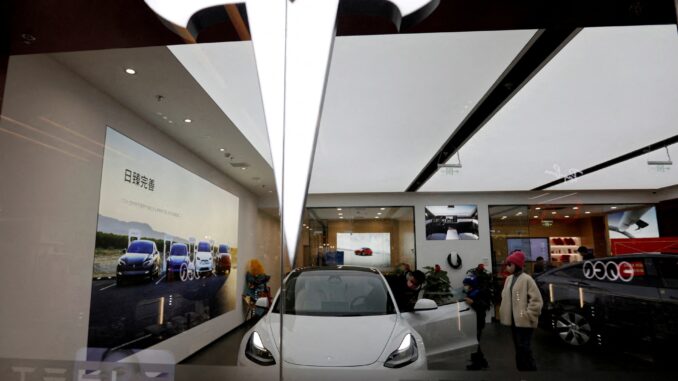
Tesla has always been willfully lousy in reporting delivery details. Today it made the obfuscation worse.
By Wolf Richter for WOLF STREET.
Tesla’s global deliveries in 2023 jumped by 38% to about 1.81 million vehicles, a new record and exceeding its guidance of 1.8 million vehicles. Deliveries in Q4 jumped by 11% from the prior quarter, and by 20% year-over-year, to 484,507 vehicles, a new quarterly record.
Tesla has always been willfully lousy in reporting delivery details. It only reports global deliveries, not US deliveries, and it lumps its models together into two categories: formerly “Model S/X” and “Model 3/Y.” All other automakers report deliveries for the US and by model.
For Q4, Tesla made that situation even worse by changing the category Model S/X to “Other Models,” and including the Cybertruck in it, along with the Model S and the Model X.
Tesla’s delivery obfuscation is particularly infuriating these days because everyone wants to know how Cybertruck production and deliveries are coming along. And Tesla said nothing.
Nevertheless: “Other Models” deliveries in Q4 (Model S, Model X, and Cybertruck), jumped by 44% from the prior quarter, and by 32% year over year, to 22,969 vehicles in Q4. By contrast, for the whole year, deliveries rose only 3% to 68,874 “other models.” So the Cybertruck has begun to move the needle in that category at the end of the year.
Tesla just started delivering the Cybertruck in November, and production ramp-up will remain tough according to Musk himself, so not a lot of Cybertrucks were produced and delivered in Q4. But Model S and Model X are slow sellers, so any surge in deliveries in that category would mostly be due to the Cybertruck.
Model 3/Y deliveries jumped by 39% in 2023, to 1.74 million vehicles. In Q4, deliveries rose 10% from the prior quarter and by 14% year-over-year, to a record 461,538 vehicles. The Model Y has become the #2 bestselling vehicle model in the US in 2023, by registrations, behind the Ford F-150 pickup truck.
Globally, China’s BYD powered past Tesla for the first time in Q4, reporting deliveries of 526,000 battery electric vehicles globally in Q4, dethroning Tesla as the #1 EV maker.
But for the whole year, BYD still lagged behind Tesla with 1.6 million battery electric vehicles (BYD also sells hybrids, which are not included here). BYD sells EVs in China and other parts of the world, including Europe, but is not yet selling them in the US (it has been assembling and selling electric buses in the US for years).
Rivian’s deliveries in Q4 jumped by 73% year-over-year to 13,972 (down a bit from the blowout Q3 numbers); for the full year, deliveries jumped by 146% to 50,122 vehicles, spread across the R1T pickup, the R1S SUV, and the EDV electric delivery van.
Rivian, the startup, outsells Ford’s electric pickup truck by a wide margin: through Q3, Ford delivered only 12,260 Lightning trucks through Q3 (Q4 results coming this week) as it is struggling with a revolt by its anti-EV dealers.
Meanwhile, US legacy automakers are fighting revolts by their anti-EV dealers.
Ford disclosed just before the holidays that about half of its dealers refused to make the investments to sell and service Ford’s EVs and cannot sell EVs and won’t sell EVs in 2024 though 2026; they’ll stick to selling only Ford’s ICE models, according to the Detroit Free Press.
A year earlier, Ford said it had enrolled 1,920 of its nearly 3,000 dealers in the EV program for the initial certification period of 2024 through 2026, but some dealers have since then backed out of the program, and the total is now down to about 1,550 dealer. The next certification period will be in 2027.
Ford said that, despite this refusal of half of its dealers, about 86% of the US population lives within 20 miles of a dealer that can sell EVs.
This is an outright revolt by Ford dealers against EVs, they’d rather not invest anything and just sell ICE pickup trucks at big-fat profit margins.
GM has run into the same type of anti-EV dealer revolt but it cracked down – rather than giving its dealers that kind of leeway; it has used buyouts to get rid of its anti-EV dealers.
Half its Buick dealers have agreed to be bought out by GM after they’d refused to get in the EV program; they gave up their Buick franchise and won’t be able to sell Buicks anymore at all, leaving GM with just 1,000 Buick dealers. GM said that nearly 90% of the US population will live within 25 miles of a Buick dealer.
GM had already bought out about 20% of its Cadillac dealers in 2020 because they refused to make the investments to sell and service its EVs.
Ford and GM have made big investments in EVs. Ford has the Mustang Mach-E and the F-150 Lightning. GM has several new EV models now entering the market or scheduled to enter the market in 2024, after ending production of the old Bolt and Bolt SUV in 2023. Stellantis dropped the ball and doesn’t really have anything on the market in terms of EVs – just announcements.
But the investments in EVs that Ford and GM have made are hard to translate into sales if their dealers refuse to sell them. Even dealers that are part of the EV programs are dogged by sales staff that are not always into selling EVs; some of them would rather sell ICE trucks and SUVs because they’re familiar with them and have confidence in selling them, and they shift customers that way.
Ford and GM are limited by state franchise laws; they must sell all their vehicles through their dealers; they cannot sell directly to consumers. They can let consumers “order” vehicles online, but the deal must ultimately go through a franchised dealer. And in terms of the classic way of selling, where the dealer is handling it from beginning to end: If dealers or their staff don’t feel like selling EVs, Ford and GM cannot sell EVs. This is an unimaginably messy problem.
Tesla was able to get exemptions franchise laws in many states, back when it was a nothing and when franchised dealers, who are a powerful lobby at the state level, still knew that EVs would never work and would never amount to anything, and that Tesla would never be a competitive threat. So Tesla can sell directly to consumers in most states, and it does not have dealers, and doesn’t have to mess with a dealer revolt.
Even Tesla cannot sell directly to consumers in about a dozen states, though it can have showrooms. In those states, Tesla has to sell vehicles from a location outside the state, such as completing the deal and delivering the vehicle in a neighboring state, or at its stores on tribal land. Not having to mess with franchised dealers has turned into another strategic advantage for Tesla.
The high supply figures of EVs that have been touted in the media as proof of the slowdown of EVs are strictly for the legacy automakers. And the examples of Ford and GM show what kinds of problems they face trying to sell EVs through their dealers. But Tesla, Rivian, and Polestar don’t have dealers, and don’t report inventories; and they’re the majority of the EV market – Tesla alone has 57% of the EV market by registrations. So “EVs piling up on dealer lots” only applies to a minority of EVs, those sold by the legacy automakers.
In terms of the stocks, Tesla and Rivian have both made it into my pantheon of Imploded Stocks, where they belong because Tesla is still hugely overvalued, and because Rivian is a huge cash-burner that will need lots of new funding, and if it doesn’t get new funding, it might not make it.
Enjoy reading WOLF STREET and want to support it? You can donate. I appreciate it immensely. Click on the beer and iced-tea mug to find out how:
ENB Top News
ENB
Energy Dashboard
ENB Podcast
ENB Substack



